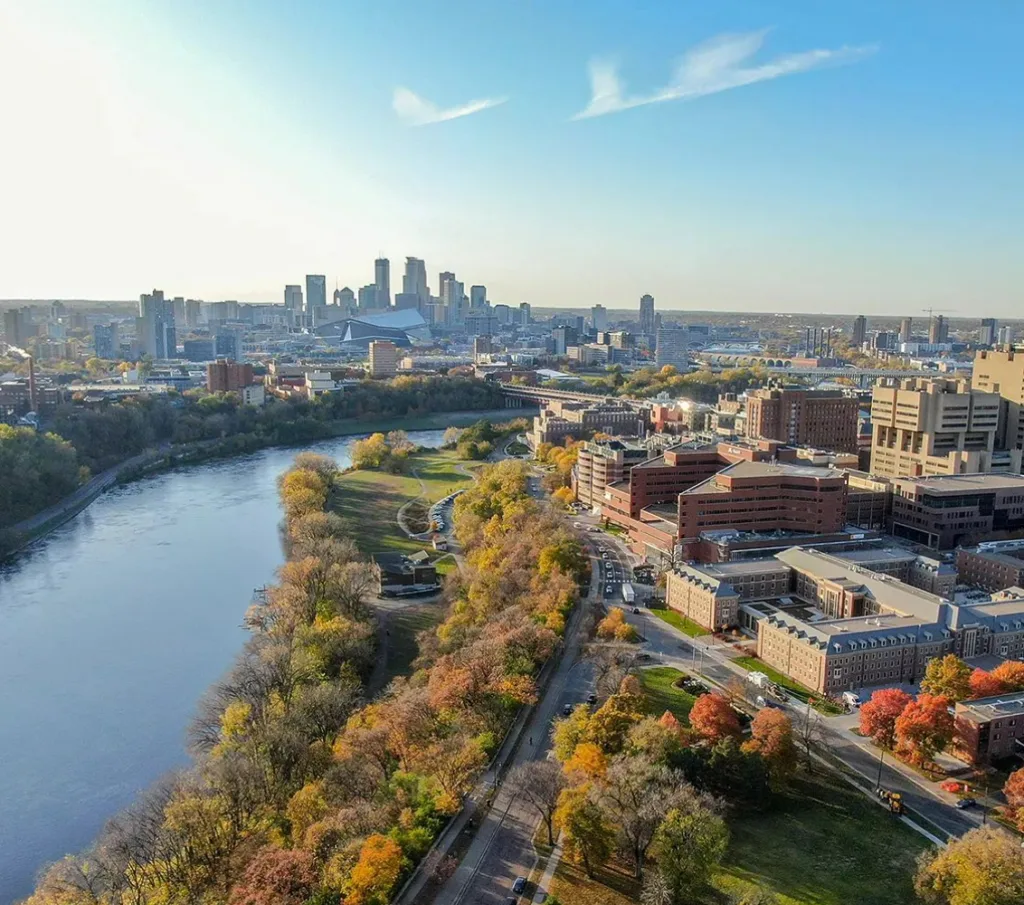
Dr. Gerald Timm Endowed Professor, UMN Department of Urology
Minneapolis/St. Paul
Endowed Professorship Opportunity – UMN Department of Urology
Dr. Gerald Timm Endowed Research Professorship
Department of Urology
University of Minnesota Medical School
Minneapolis, Minnesota
Position Overview
The University of Minnesota Medical School invites applications for the prestigious Dr. Gerald Timm Endowed Professorship in the Department of Urology. Options for Tenure, Tenure-Track, and Non-Tenure are available based on the candidate’s credentials and preferences. The successful candidate will be appointed at the rank of Associate Professor or Full Professor.
The Department of Urology at the University of Minnesota Medical School is a dynamic and growing department dedicated to advancing the understanding and treatment of urological diseases and disorders. The department comprises a diverse group of faculty members engaged in cutting-edge research, innovative clinical care, and comprehensive education and training programs.
Key Responsibilities
- Develop and maintain independent, vigorous, externally funded research programs in engineering related to urology, with a focus on neuro or functional urology.
- Collaborate with clinical faculty in research design, analysis, reporting, publishing, and grant award processes.
- Provide mentorship and guidance to junior faculty, fellows, residents, and graduate students.
- Contribute to the department’s educational mission through teaching and curriculum development.
- Participate in departmental, school, and university service activities.
- Engage in translational research, moving discoveries from bench to bedside.
- Foster interdisciplinary collaborations across the University and with industry partners.
- Contribute to the advancement of knowledge in the field through publications, presentations, and other scholarly activities.
Qualifications
- PhD, MD, or equivalent degree from an accredited institution.
- Demonstrated scholarly expertise in engineering applications to urology.
- Outstanding record of research and scholarship in the field of urological engineering, as evidenced by publications in high-quality, peer-reviewed journals and presentations at national and international conferences.
- Demonstrated success in obtaining and maintaining extramural funding, preferably from federal sources such as NIH or NSF.
- Excellent communication, interpersonal, and collaboration skills.
- Commitment to fostering a diverse and inclusive research and educational environment.
- Experience in mentoring graduate students, post-doctoral fellows, and junior faculty.
- Track record of successful collaboration with clinical researchers and industry partners.
Endowment Details
- Official Title: Dr. Gerald W. Timm Endowed Professorship in Neurourology and Urologic Engineering
- Principal Amount: $1.3 million
- Use: The income may be used for salary supplement, research support, travel or other purposes as approved by the Head of the Department of Urology

Department of Urology
The University of Minnesota Department of Urology has been at the forefront of urologic patient care, education, and teaching for more than ninety years. Building on our past, we continue to lead innovative efforts in several areas of urology, including cancer, stones, infertility, and pediatric care. Throughout those years, we have cared for countless patients, trained hundreds of talented urologists, including many leaders in our discipline, and contributed significantly to the advancement of the field.
Department By the Numbers:
- 21 Faculty
- 15 Residents
- 2 Fellowship Programs
University of Minnesota Medical School
Ranked among the top public research institutions in the United States, the UMN Medical School is committed to innovation, collaboration, and improving health through cutting-edge research. Our faculty receives more than $200 million in research grants annually, and we’re home to numerous centers of excellence and innovative research programs.
Institute for Engineering in Medicine (IEM)
The IEM brings together faculty from the Medical School and College of Science & Engineering to foster interdisciplinary research, education, and innovation. Key focus areas include:
- Medical and biological imaging
- Cardiovascular engineering
- Neuroengineering
- Cellular and molecular bioengineering
College of Science & Engineering
Department of Biomedical Engineering
Ranked among the top biomedical engineering programs nationally, the department focuses on interdisciplinary research in areas such as:
- Neural engineering
- Cardiovascular engineering
- Cellular and molecular bioengineering
- Medical devices and instrumentation
Department of Mechanical Engineering
With strengths in areas crucial to urological engineering, including:
- Robotics and controls
- Biomechanics
- Microfluidics and nanoengineering
Earl E. Bakken Medical Device Center
A state-of-the-art facility that fosters innovation in medical device design and development. It offers:
- Prototyping facilities
- Educational programs in medical device innovation
- Collaborative spaces for industry partnerships
Center for Magnetic Resonance Research (CMRR)
A world-class facility for advanced imaging research, featuring:
- Ultra-high field MRI scanners (up to 10.5 Tesla)
- Cutting-edge spectroscopy and imaging techniques
- Collaborative opportunities for developing new imaging methodologies

Unique Opportunities
Medical Alley
Minnesota’s thriving biomedical industry ecosystem, known as Medical Alley, offers unparalleled opportunities for collaboration and innovation:
- Home to major medical device companies like Medtronic and Boston Scientific
- Vibrant startup ecosystem in medical technology
- Networking and partnership opportunities through the Medical Alley Association
Neuromodulation Research
The University of Minnesota is at the forefront of neuromodulation research, offering:
- MNDrive Brain Conditions initiative, supporting interdisciplinary research in neuromodulation
- Annual Minnesota Neuromodulation Symposium, bringing together leaders in the field
- Partnerships with industry leaders and startups in neuromodulation technology
Technology Commercialization
The University’s technology commercialization team provides comprehensive support for translating research into real-world applications:
- Intellectual property protection
- Licensing support
- Startup company formation
- Industry partnerships
About the University of Minnesota
The University of Minnesota is a top-tier research institution located in Minneapolis-St. Paul, with a long-standing reputation for academic excellence and innovation. With more than 50,000 students, it is one of the largest universities in the United States, offering a wide range of undergraduate and graduate programs across a diverse array of fields. The university boasts a high graduation rate and a strong commitment to research, with over $1 billion in research expenditures each year.

Location
Minneapolis & Saint Paul, Minnesota
The Minneapolis-Saint Paul area is cosmopolitan at its heart and small towns along its perimeter. The Twin Cities is the 16th largest metro area in the US, with a population of approximately 3.4 million people. It is the 2nd largest economic center in the Midwest, behind Chicago, and the second-largest medical device manufacturing center in North America.
Fortune 500 Companies in MSP
Minneapolis proper contains the 5th highest concentration of Fortune 500 companies in the country. The presence of the corporate headquarters for companies such as Target, US Bancorp, Xcel Energy and Ameriprise Financial provide a growing economy with great job opportunities for a candidate’s spouse or family.
Arts & Culture
Additionally, an exciting arts and music scene, exceptional shopping, award-winning restaurants, wineries and craft breweries, and distinctive accommodations can be found throughout the area. Outdoor enthusiasts find plenty to do – even when temperatures dip, the variety of fun outdoor adventures does not. Sports fans cheer on their favorite team year-round. Big city bustle or small-town charm, anyone can find the activity that suits them in the Minneapolis – Saint Paul Area.
Minneapolis-St. Paul is a metropolitan area in the heart of the Midwest, and the largest city in the state of Minnesota. It offers a high quality of life, excellent public schools, and a strong economy, consistently ranking as one of the best places to live in the United States. The area boasts a thriving arts and culture scene, with world-class museums, theaters, and music venues, as well as extensive park systems, lakes, and trails for outdoor enthusiasts.
Hub for Medical Innovation & Research
Minneapolis-St. Paul is recognized as a hub for medical innovation and research, with numerous healthcare organizations, including the world-renowned University of Minnesota Medical School, located in the region. Despite its many amenities, the area has a relatively low cost of living compared to other major metropolitan areas in the United States.
Twin Cities – a Rich History
The Twin Cities also have a rich history of diversity and inclusion, and the University of Minnesota is committed to fostering a welcoming and inclusive community. Additionally, Minneapolis-St. Paul has a well-developed transportation system, including a light rail system, bus network, and extensive bike paths, making it easy to get around without a car. Overall, Minneapolis-St. Paul offers a unique blend of urban sophistication, natural beauty, and cultural diversity that make it an attractive location for professionals in a variety of fields, including medicine and healthcare.
How To Apply
The University of Minnesota Medical School has retained the services of Academic Med to assist with this strategically important search. The search for this esteemed position is being conducted by Academic Med Principals – Gentry Zacheis & Jim Hagood. Interested candidates should submit their curriculum vitae, a cover letter, and three references to Jim Hagood, Managing Principal, at jim@academic-med.com. All inquiries, nominations, and applications will be handled with confidentiality.
EEO/AA Statement
The University of Minnesota is an Equal Opportunity/Affirmative Action employer. All qualified applicants will receive consideration for employment without regard to race, color, creed, religion, national origin, gender, age, marital status, disability, public assistance status, veteran status, sexual orientation, gender identity, or gender expression. The University is committed to building a diverse faculty and strongly encourages applications from female and minority candidates.



